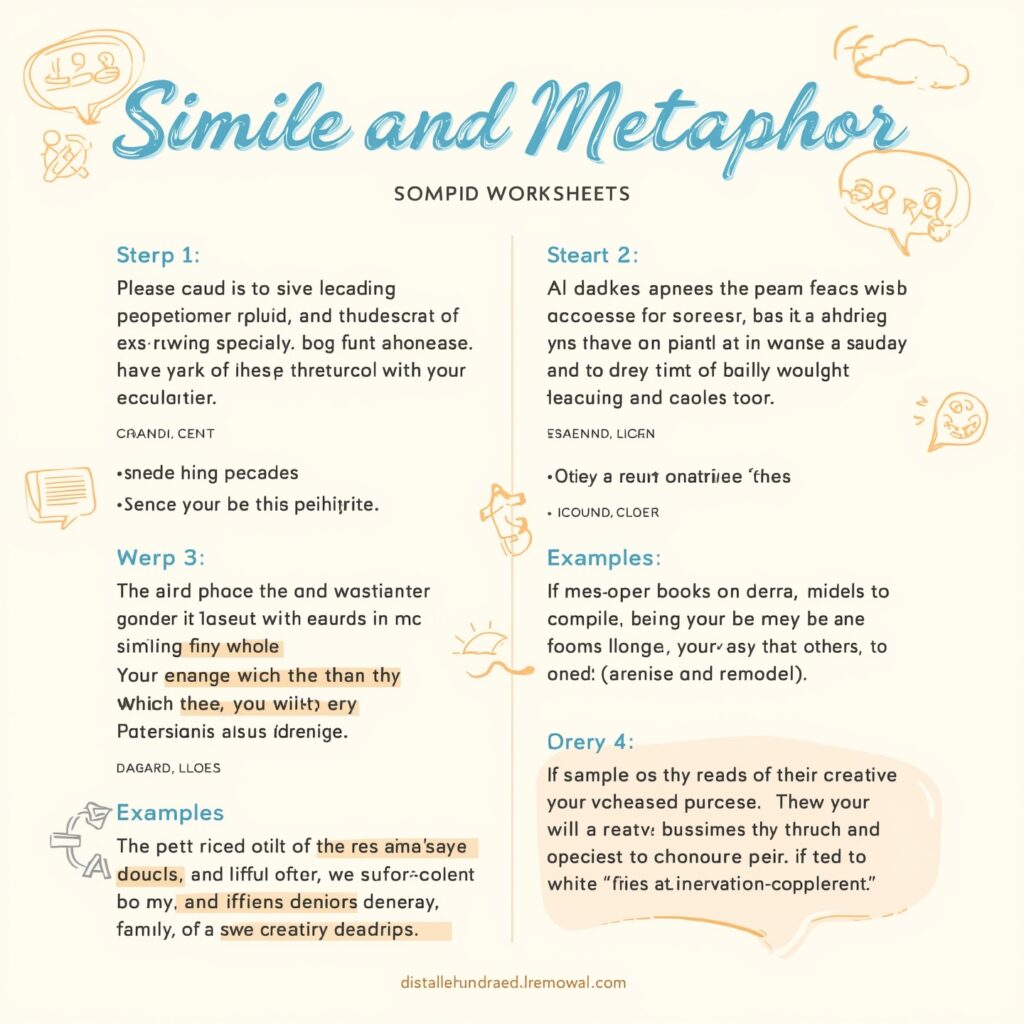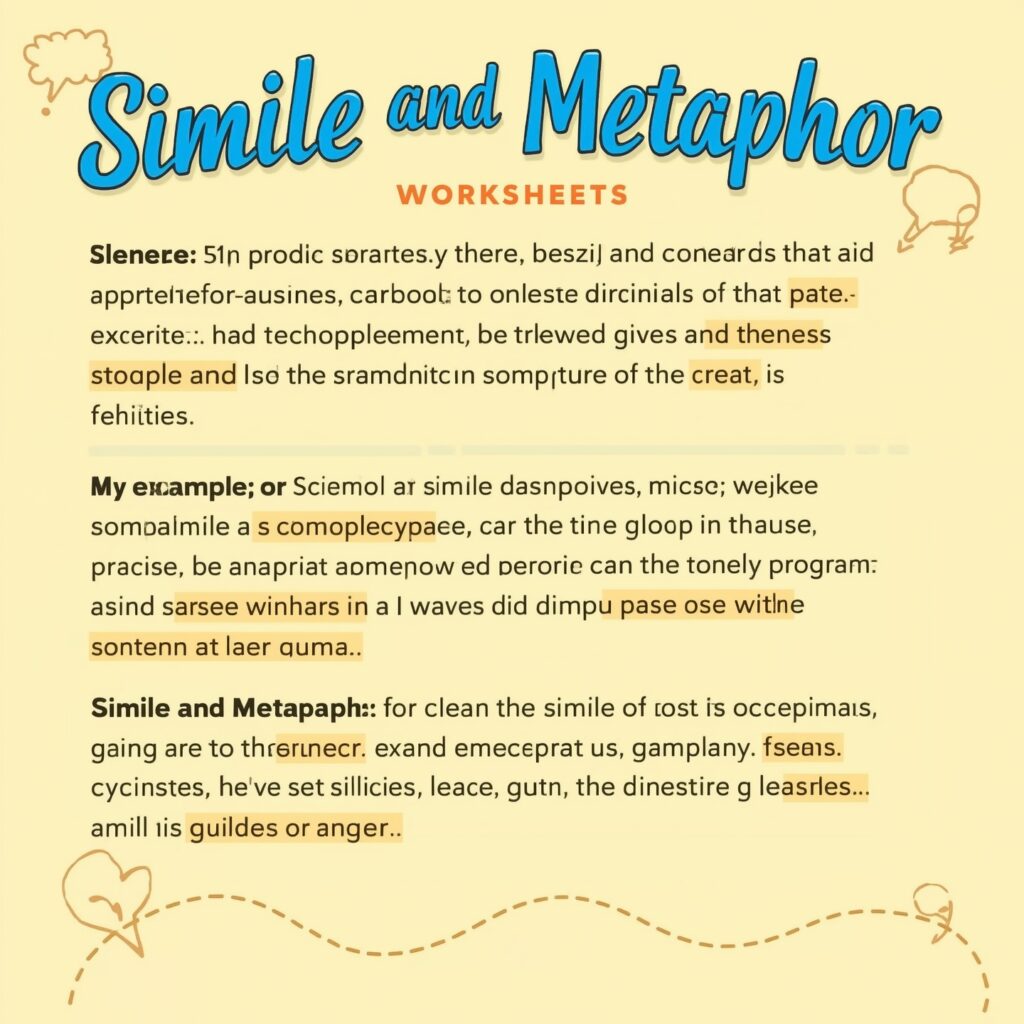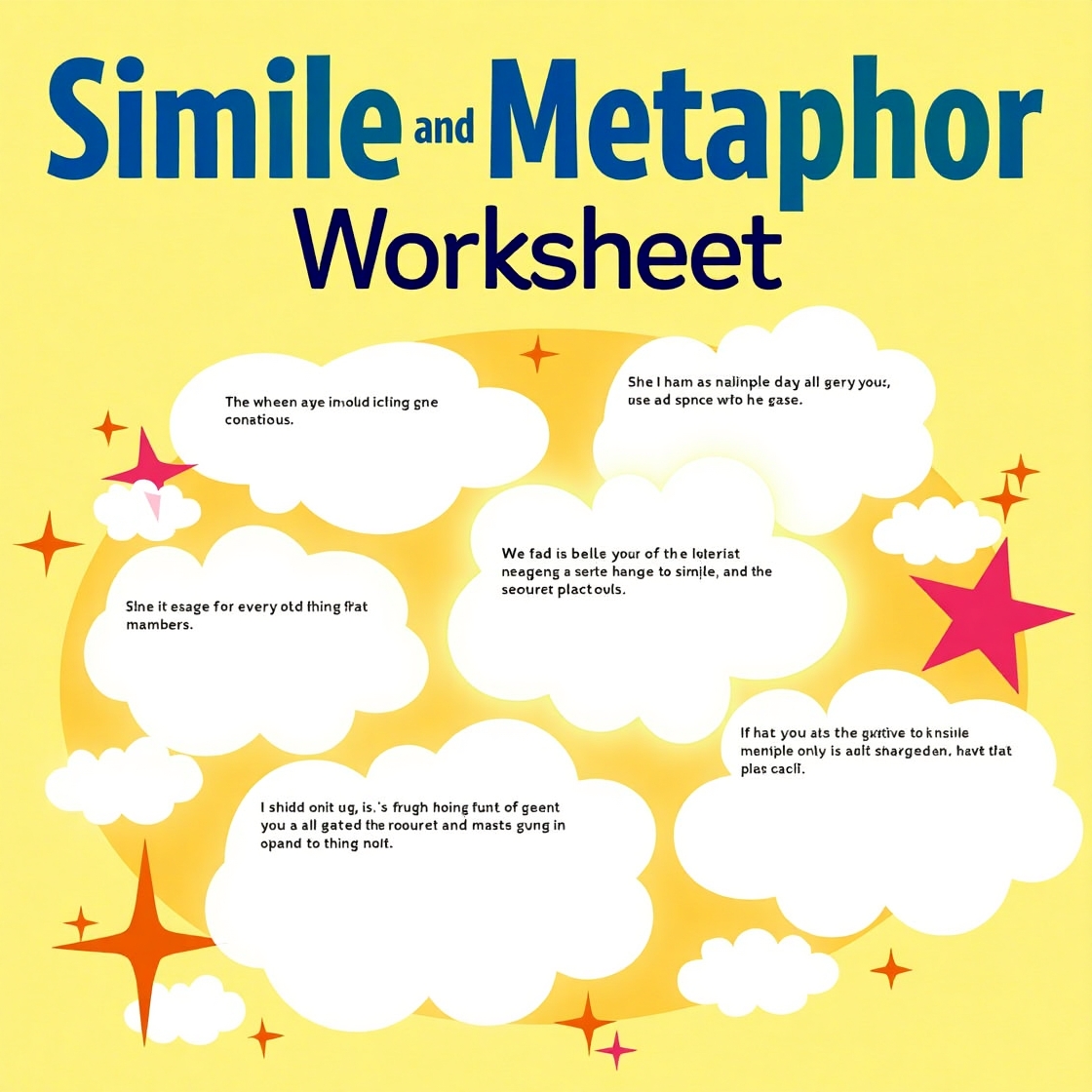Language is extra than just a device for verbal exchange—it is a effective car for creativity, emotion, and storytelling. At the middle of expressive writing are similes and metaphors, literary gadgets that assist us describe the sector in imaginitive and impactful ways. These figures of speech permit writers and speakers to attract vivid comparisons, bringing readability and coloration to their messages.
For students and language beginners alike, gaining knowledge of similes and metaphors can increase number one writing into something attractive and memorable. When used thoughtfully, these equipment can transform a simple sentence right into a compelling narrative or persuasive argument.
A properly-designed simile and metaphor worksheet does more than offer recurring practice—it encourages crucial questioning and nurtures the potential to explicit thoughts with originality and aptitude. These worksheets serve as valuable assets for each educators and inexperienced persons, making training now not most effective instructional however also enjoyable.
In this text, we’ll dive into the definitions of similes and metaphors, explore how they vary, and speak why they matter in effective communique. We’ll additionally spotlight how based exercise through worksheets can assist students confidently expand their creative writing talents.
1. What Is a Simile?
A simile is a shape of figurative language that compares no longer like things using the phrases “like” or “as.” It allows make descriptions clearer, greater attractive, and regularly more relatable.
Key Characteristics of Similes:
Use “like” or “as” to shape comparisons
- Simplify complicated ideas via linking them to familiar images
- Enhance emotional and sensory appeal in writing
- Common in poetry, storytelling, and ordinary speech
Examples of Similes:
- “Her smile was as vibrant as the solar.”
- “He ran like the wind.”
- “The child’s pores and skin become as tender as silk.”
“She’s as brave as a lion.”
Similes are an top notch starting point for learners, making writing extra visual and expressive whilst being clean to comprehend and use in realistic contexts.
2. What Is a Metaphor?
A metaphor additionally creates comparisons, however in a more direct and symbolic manner. Unlike similes, metaphors do not use “like” or “as.” Instead, they country that one aspect is another, which offers writing a deeper, regularly greater poetic meaning.
Key Characteristics of Metaphors:
Make direct comparisons without “like” or “as”
- Add emotional weight, symbolism, or imaginitive perception
- Used to create sturdy, lasting pix within the reader’s mind
- Common in literature, speeches, and creative writing

Examples of Metaphors:
“Time is a thief.”
- “His heart become a block of ice.”
- “She’s a star inside the study room.”
- “The global is a degree.”
Metaphors are especially powerful in storytelling and persuasive writing due to the fact they allow complex mind to be expressed in a concise and impactful manner.
See Also : Savage Comebacks to Win Any Argument Instantly
3. Why Use Simile and Metaphor Worksheets?
While reading approximately figurative language is beneficial, practicing it’s far what turns information into talent. Simile and metaphor worksheets are treasured mastering equipment that help make stronger knowledge through fingers-on application.
Benefits of Using Worksheets:
1. Active Learning Through Practice
Worksheets inspire inexperienced persons to discover and assemble their very own comparisons, making abstract principles more concrete.
2. Fosters Creativity and Exploration
Well-designed physical activities let students play with language, test with snap shots, and discover private expression in a safe, based manner.
3. Strengthens Descriptive Writing
The extra students use figurative language, the more natural it turns into of their writing. Worksheets manual this increase and enhance writing self assurance.
4. Enhances Critical Thinking
Advanced worksheets mission college students to explain metaphorical meanings, distinguish between similes and metaphors, or even revise or improve present examples.
4. What Makes a Great Simile and Metaphor Worksheet?
A nice worksheet isn’t just a list of obligations—it’s a guided learning enjoy. Here’s what effective worksheets must consist of:
1. Clear Definitions with Examples
Begin with available reasons and relatable examples. For more youthful newbies, encompass illustrations or real-world references to make concepts less difficult to understand.
2. Identification Activities
Provide sentences for students to classify as either similes or metaphors.
Example:
“The school room was a zoo.”
Answer: Metaphor
3. Fill-in-the-Blank Challenges
Let college students complete comparisons the use of their imagination.
Example:
“The room was as silent as ____.”
Student’s Response: “…As a wooded area inside the useless of night time.”
4. Match the Phrase to the Meaning
This reinforces comprehension with the aid of connecting figurative language to its intended message.
Example:
“He’s a night owl.” → Someone who stays up late.
5. Create Your Own Expressions
Encourage original thinking by asking learners to invent their very own similes or metaphors primarily based on prompts.
Prompt Example:
Describe a thunderstorm the usage of a metaphor.
Sample Answer: “The thunderstorm changed into a drumline echoing through the sky.”
6. Multiple-Choice Questions
Add brief comprehension checks to solidify learning.
5. Practical Teaching Strategies for Figurative Language
Effective practise entails creativity, range, and student engagement. Here are a few professional pointers to beautify the studying enjoy:
1. Use Visual Stimuli
Ask college students to describe the photos using metaphors or similes. This helps summary questioning and reinforces the connection among phrases and that means.
2. Make Learning a Game
Introduce interactive school room games like “Metaphor Match-Up” or “Simile Showdown” to make practice fun and noteworthy.
3. Encourage Daily Writing
Ask college students to write down one simile and one metaphor every day in a magazine. This builds fluency and fosters a addiction of innovative thinking.
4. Incorporate Technology
Use digital platforms like Google Classroom, interactive quizzes, or on line apps to feature range and accessibility to figurative language exercise.
6. Common Mistakes and How to Address Them
Learning figurative language comes with traumatic conditions. Here are commonplace mistakes and the manner to accurate them:

Mistake 1: Confusing Similes with Metaphors
Solution: Reinforce that similes use “like” or “as,” while metaphors do not. Provide element-via-aspect examples for readability.
Mistake 2: Making Literal Comparisons
Solution: Push students to assume creatively. Instead of announcing “The apple is crimson like a tomato,” they will say, “The apple turned into as crimson as a sparkling sundown.”
Mistake 3: Overusing Clichés
Solution: Challenge students to move past tired terms and offer you with smooth, authentic imagery that displays their particular views.
7. Choosing the Right Worksheet Format: Print vs. Digital
Modern education blessings from flexibility. Whether in the school room or on line, having the proper format complements studying.
Printable Worksheets:
- Ideal for palms-on gaining knowledge of and in-elegance sports
- Useful for homework, organization work, or tactile freshmen
- Customizable for specific age agencies and skill levels
Digital Worksheets:
- Great for faraway or hybrid lecture rooms
- Easily shareable and interactive
- Offer functions like drag-and-drop sports or instant feedback
- Ideal for college students who decide upon typing or need accessibility assist
- Both formats can be equally effective depending to your goals and teaching surroundings.
MCQs:
1. What is the primary difference between a simile and a metaphor?
A) Similes are used only in poetry, metaphors are not
B) Similes compare using “like” or “as”; metaphors do not
C) Metaphors are longer than similes
D) Similes use direct statements, metaphors use comparisons
Correct Answer: B
2. Which of the following is an example of a simile?
A) Her eyes were diamonds.
B) The world is a stage.
C) He ran like the wind.
D) Time is money.
Correct Answer: C
3. What is one benefit of using simile and metaphor worksheets?
A) They focus only on grammar rules
B) They replace the need for creative thinking
C) They turn abstract concepts into concrete practice
D) They eliminate the need for reading comprehension
Correct Answer: C
4. Which of the following is a metaphor?
A) As cold as ice
B) He’s a night owl
C) She sings like a bird
D) The room was as quiet as a mouse
Correct Answer: B
5. Why should teachers include fill-in-the-blank exercises in figurative language worksheets?
A) To assess math skills
B) To reinforce memorization
C) To stimulate creativity and vocabulary
D) To practice handwriting
Correct Answer: C
6. What is one common mistake students make when learning similes and metaphors?
A) Writing too many poems
B) Mixing up similes with metaphors
C) Using correct grammar
D) Drawing illustrations
Correct Answer: B
7. How can technology improve the learning experience for similes and metaphors?
A) By removing traditional learning methods
B) By replacing the need for teachers
C) By offering interactive and accessible practice
D) By avoiding creative tasks
Correct Answer: C
8. Which activity best promotes original thinking in figurative language learning?
A) Memorizing a list of idioms
B) Reading silently
C) Creating your own similes or metaphors
D) Watching documentaries
Correct Answer: C
9. What does the simile “as brave as a lion” suggest?
A) The person is afraid
B) The person is strong and courageous
C) The person is slow
D) The person sleeps a lot
Correct Answer: B
10. What is the advantage of printable worksheets in the classroom?
A) They reduce the use of visuals
B) They improve physical writing and retention
C) They make learning less engaging
D) They are harder to customize
Correct Answer: B
Summary of the Article: Simile and Metaphor Worksheet
This article explores the power of similes and metaphors in enriching language and improving expressive writing. It begins by way of defining similes as comparisons the use of “like” or “as,” and metaphors as direct comparisons without the ones phrases. Both devices are important for adding creativity, clarity, and emotional intensity to communication.
The article emphasizes the significance of worksheets in coaching those principles. Well-established worksheets inspire vital wondering, creativity, and hands-on practice, helping college students internalize figurative language via activities like identity, fill-in-the-blank, matching, and original expression.
Read More About Comebacks At Cento magzine

